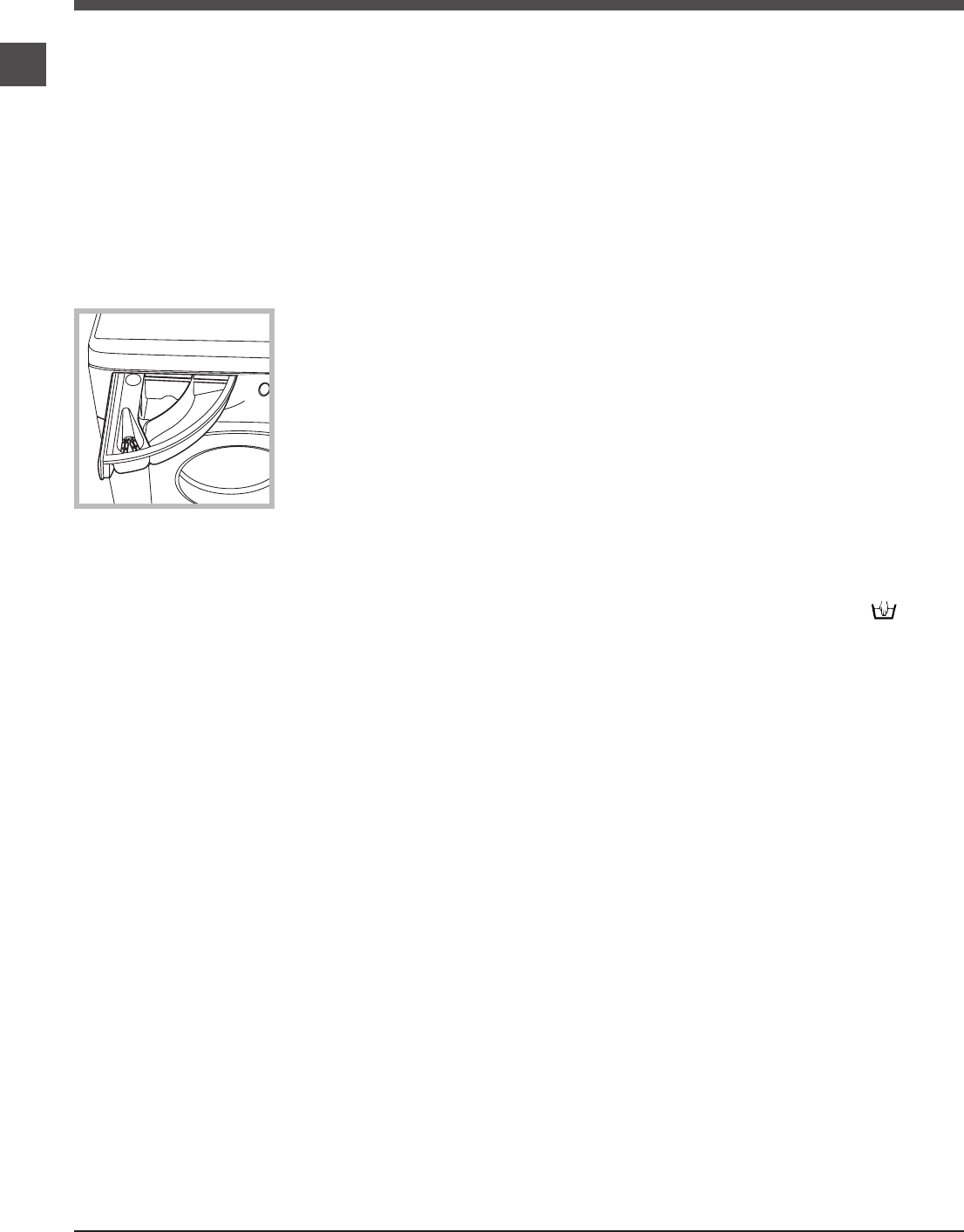
12
GB
Detergents and laundry
Detergent dispenser drawer
Good washing results also depend on the correct dose of
detergent: adding too much detergent will not necessarily
result in a more efficient wash, and may in fact cause a
build up on the inside of your appliance and contribute to
environmental pollution.
! Do not use hand washing detergents because these create
too much foam.
! Follow the instructions given on the detergent packaging.
! Use powder detergent for white cotton garments, for pre-
washing, and for washing at temperatures over 60°C.
Open the detergent di-
spenser drawer and pour
in the detergent or washing
additive, as follows.
! Do not pour detergent into the middle compartment (*).
Detergent should only be poured into the compartment 1.
compartment 1: Detergent for the wash cycle (powder
or liquid)
For best results liquid detergent should be poured in the
dispenser immediately before the start of the programme.
compartment 2: Additives (fabric softeners, etc.)
The fabric softener should not overflow the grid.
Preparing the laundry
• Divide the laundry according to:
- the type of fabric/the symbol on the label
- the colours: separate coloured garments from whites.
• Empty all garment pockets and check the buttons.
• Do not exceed the listed values, which refer to the
weight of the laundry when dry: see “Table of wash
cycles”.
How much does your laundry weigh?
1 sheet 400-500 g
1 pillow case 150-200 g
1 tablecloth 400-500 g
1 bathrobe 900-1200 g
1 towel 150-250 g
Garments requiring special care
Cotton Standard 20°: this wash cycle 4 ideal for lightly soi-
led cotton loads. The effective performance levels achieved
at cold temperatures, which are comparable to washing at
40°, are guaranteed by a mechanical action which operates
at varying speed, with repeated and frequent peaks.
Shirts: use special wash cycle 8 to wash shirts in various
fabrics and colours.
It guarantees maximum care is taken of the garments and
minimises the formation of creases.
Goodnigt Cycle (wash cycle 9). This is a silent cycle which
can be run at night, when the electricity prices are lower. The
wash cycle is designed for cottons and synthetics. At the end
of the cycle the machine stops while there is still water in the
drum; to spin and drain the laundry press the START/PAUSE
button; alternatively the machine will perform the spin cycle
and drain the water automatically after 8 hours.
Baby Cycle: this wash cycle 10 can be used to remove
the soiling typically caused by babies, while ensuring that
all detergent is removed from nappies in order to prevent
the delicate skin of babies from suffering allergies. The
cycle has been designed to reduce the amount of bacteria
by using a greater quantity of water and optimising
the effect of special disinfecting additives added to the
detergent.
Lingerie Cycle: for undergarments of any colour, in any
fabric. Use special wash cycle 11.
Silk: use special wash cycle 12 to wash all silk garments.
We recommend the use of special detergent which has
been designed to wash delicate clothes.
Curtains: fold curtains and place them in a pillow case or
mesh bag. Use wash cycle 12.
Wool: all wool garments can be washed using programme
13, even those carrying the “hand-wash only” label.
For best results, use special detergents and do not exceed
1 kg of laundry.
Load balancing system
Before every spin cycle, to avoid excessive vibrations and
to distribute the load in a uniform manner, the drum rotates
continuously at a speed which is slightly greater than the
washing rotation speed. If, after several attempts, the load
is not balanced correctly, the machine spins at a reduced
spin speed. If the load is excessively unbalanced, the
washing machine performs the distribution process instead
of spinning. To encourage improved load distribution and
balance, we recommend small and large garments are
mixed in the load.
1
2
*


















